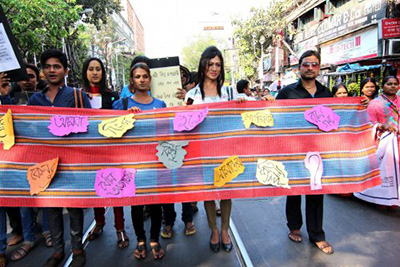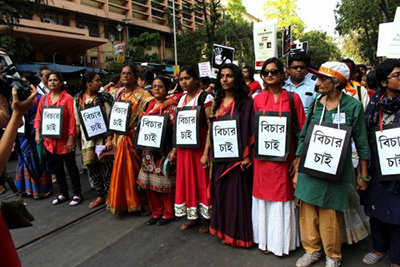by Soma Marik
April 14, 2015
A historical rally involving women, men, and trans activists took place protesting the whole of rape culture and not just a few cases. The proposal for the demonstration grew out of an initiative originating in Maitree, a West Bengal based women’s right network incorporating Women’s organisations, NGOs, and individuals. Maitree observes International Women’s Day every year. Individual member organizations have their programmes, and Maitree has a collective programme. However, it was felt by many members early in 2015 that the scale of violence, especially sexual violence on women and LGBT persons, sex-workers and all marginals was going beyond anything seen in the past. This calls for response on a much more sustained and united level.

At the same time, it was evident that political forces were using rapes and sexual violence, on one hand to intimidate political opponents, and on the other as a campaign to garner votes by appearing as champions of the “correct” kind of rape victims. Above all state backed aggressive-consumerism has been reinforcing the rape culture which thrive also on valorization of masculinity.
So an attempt was made to call forces beyond Maitree. A series of notified meetings were held. Even while these were happening, rape was becoming more and more a daily occurrence, in West Bengal, in India. In Birbhum, a man joined BJP. So his aunt, living in a part of Burdwan near Birbhum, was assaulted, sexually abused, and even refused medical treatment. In Ranaghat, a 74 year old woman, a nun, was raped. And following the death of Suzette Jordan one of the accused was seen moving around proudly, as though telling the world that they had nothing to fear.
In order to ensure that the widest range of forces were able to come, the date was fixed for 19th March, so that we can have many rights groups by our side from different parts of West Bengal. The basic political outlook was worked out in the meetings, involving a concept note, which put forward a brief explanation and a set of demands. A few key issues were: that this was a mobilization that did not see any mainstream party, including the mainstream left, as saviours. A set of basic demands were presented, mainly to generate public awareness about what can be our demands. Hence, for example, the stress was not so much on new laws, but on implementation of laws, creation of rape crisis centres, etc. We also focused on State violence, AFSPA, and neo-liberal violence which escalate sexual violence
Two debates were conducted. One was over whether there should be any attempt at a lasting structure. While this was not fully answered, the slogan of the march was From Ten to Ten Thousand, We Will Come Out on the Streets Repeatedly. Clearly, this implied the need for sustained campaigns and therefore hinted at the formation of a issue-based forum. The second was over whether there should be organizational banners of the mass organizations including students. After considerable debate, for this programme, it was decided that there would not be separate organizational banners. We were keen on highlighting plurality of organizations and clean politics. Our aim was to ensure that organizations willing to stand up for the rights of women, of marginal sexualities, who should own the programme, and come as organizations. But given the debate, we agreed upon coming without a banner for the moment.
The demonstration was to be preceded by a gathering at College Square, at 2:30 PM. By that time, there was a mass that spilled out of the Square. The police were clearly taken aback, as they had been predicting a turnout of around 250-300. By 2:50, when the demonstration could finally be organized and when it started moving, over 2,000 people had already gathered. People were still coming in, and by the time the demonstration marched along Nirmal Chandra Street, then on to Bow Bazar, and finally up S. N. Banerjee Street, one of us had walked up and down, trying to do an actual count. It appeared that the figure was between 2,500 and 3,000. The huge pressure at the front made a more accurate count impossible.
The demonstration was remarkable for its diversity cutting across class, community, gender. At least a dozen of the constituents of Maitree had come, including very senior members. Remarkable were the women who were walking with crutches, or using tricycles. Women with disabilities, they had come to draw attention to the sexual violence on women with disabilities which is being daily invisibilized. A large number of women workers, united in the Karmajibee Mahila Parishad with women in unorganized sectors. Indeed, they had brought far, far more people to the demonstration than some of those who had insisted that they could come only if there was no banner. Some of these latter were conspicuously absent.

Both APDR and MASUM, two human rights organizations, had come. The USDF, a student organisation had come, as had Campus Resist, a collectivity including students, teachers, and concerned citizens. The All India Progressive Women’s association and the All India Students Association had come with quite a number of activists. We cannot list every organization, for three reasons. First, none had brought banners, though many had placards with slogans where their names also figured. Second, because there were no banners, many were seen as individuals, who in reality might have come from some organization. Finally, we do not feel any need to post the names of every organisation whose members had come, in a public Facebook post, which is often trawled, as past experiences show, by both people in right wing politics and the police.
A good number of sex workers, united in their organization Durbar Mahila Samannay Committee, had come. And there were a number of LGBTs, some coming from the organization Sappho for Equality, and others not necessarily organized, but coming out, because they saw a need to express their problems, notably the sexual violence on trans-people. Cultural activists had come, including Ganabishan, and various individuals. The demonstration started after a short talk explaining why we were organizing the programme. It ended in Esplanade, after a human chain, followed by a cultural programme. I am trying to bring out the whole diversity through the pictures I post along with this note.
This is of course a personal account, and does not pretend to be an official stance. But having had the privilege of working with a good many comrades, women as well as some men, who were key to mobilizing , planning, and making the programme such a vibrant and successful one, I feel it necessary to stress that without those people, who had been working tirelessly in the organizational meetings, in deciding the politics of the campaign through the concept note and the leaflet, in getting in touch with diverse organizations, in negotiating a united programme, the rally would not have had even half the numbers it did have. This was possible because commitment to the struggle was paramount for them.
Soma Marik is an Associate Professor of History, RKSM Vivekananda Vidya Bhavan, Calcutta. She is an activist in Nari Nirjatan Pratirodh Mancha (Forum Against Oppression of Women, Caluctta) and the network Maitree. This account was previously published on Facebook and on International Viewpoint.
